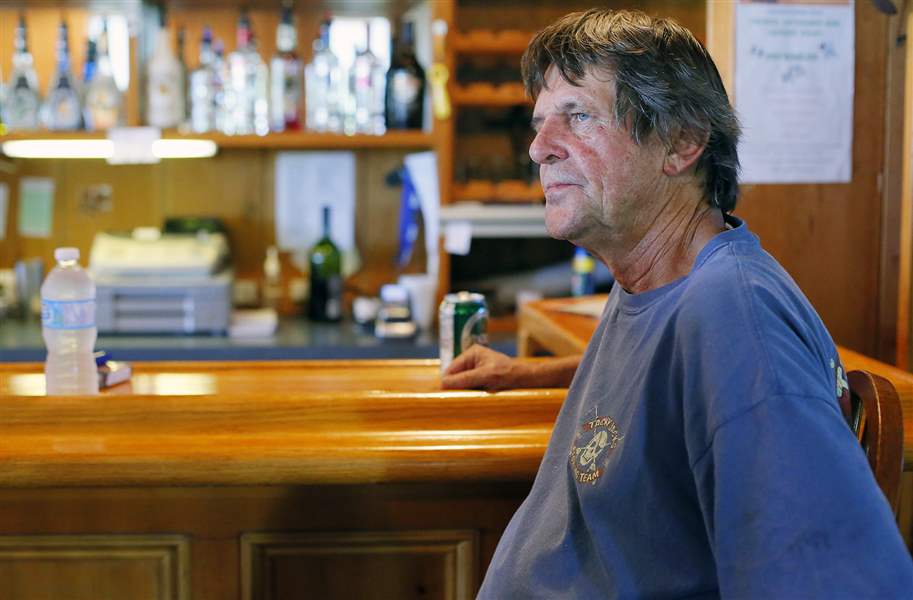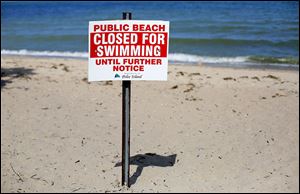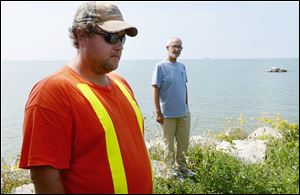
Pelee Island water doesn’t make waves
Most remain calm to toxic algae threat
8/28/2014
Richard Hamm, at the bar of his Scudder Beach Bar and Grill on Pelee Island, keeps calm about water quality concerns, even as a big tourism weekend approaches.
THE BLADE/AMY E. VOIGT
Buy This Image

Richard Hamm, at the bar of his Scudder Beach Bar and Grill on Pelee Island, keeps calm about water quality concerns, even as a big tourism weekend approaches.
PELEE ISLAND, Ontario, Canada — Sean McNeil waded sandal-deep in Lake Erie’s gently lapping waves, unperturbed by a bright red sign just yards away warning of a beach closure.
The scenic shoreline stretch, like other beaches on this tranquil Canadian island about 22 miles north of Sandusky, was closed for swimming Wednesday because of an algae bloom and high microcystin readings.
Mr. McNeil, like several other Pelee Island visitors and residents, took a calm view.
PHOTO GALLERY: Click here to view slideshow.
“We were stand-up paddle boarding yesterday and swimming on the other side of the island,” said Mr. McNeil, who lives in Windsor, Ont., and works as a customs agent on the island. “And really, it’s just algae.”
A public health notice issued on Tuesday urged avoiding swimming and cautioned against drinking water from private shoreline wells that draw water from the lake, where two sites showed elevated microcystin levels.
The majority of Pelee’s roughly 500 cottages and homes rely on such wells for water, which officials said could be tainted by harmful algae. Those residents were advised to use bottled water or pick up water from a tanker at the municipal treatment plant, where the toxin was not detected in treated water.
The alert put many islanders in the same tough spot that 500,000 metro Toledo residents found themselves in earlier this month when the city issued a do-not-drink advisory because of toxic algae.
On Pelee, residents and businesses dealt with the water advisory even as they enjoyed the last sultry days of summer and readied for Labor Day weekend. The holiday shared by Canada and the United States provides an end-of-season tourism boost.
Preparation, not panic, served as the mantra of many.
A red-and-white maple leaf wind socket fluttered in the breeze outside Scudder Beach Bar and Grill. Inside, owner Richard Hamm sat at the end of his bar and appeared unflappable.
He booked bands to play this weekend, though he’s heard from at least one motel that a few travelers have canceled their island getaways because of the water alert.

Signs on Pelee Island were one of many methods used to warn residents and tourists of water issues. Hun-dreds of fact sheets and notices were distributed too.
He doesn’t think the bar’s well, which uses an ultraviolet and chlorinated system, has a problem. Still, he stocked up on 200 pounds of ice from mainland Canada and served bottled water Wednesday.
“Better safe than sorry,” he said. “Until we get tested, we won’t take the chance.”
Mr. Hamm planned to brush his teeth with bottled water at home, where he has a shore well.
The advisory was based on a visual observation of the bloom thickening up around the island, according to Kate Jordan, Ontario Ministry of the Environment and Climate Change spokesman.
Tests showed readings of greater than 5 parts per billion at two locations on the northwest and southwest sides of the island, and the municipality is awaiting more results, said Kyle Davis, environmental services manager for the municipality of Pelee Island.
The island tests for microcystin about once a week. Last week it tested twice, and it has now stepped up the schedule to four times a week, he said. Sampling was accelerated after the local water crisis, which Mr. Davis calls “the Toledo incident.”
“Anybody that historically knows about blue-green algae was interested in Toledo,” he said.
The island’s municipal system serves just 28 customers, including many businesses. Since 2010, it has operated under an unrelated boil-water advisory because of water pressure drops that can affect the treatment process. That advisory has been temporarily rescinded, officials said.
Mike Tudor, Windsor-Essex County Health Unit inspection manager, said his agency hadn’t received many water quality calls; islanders seemed to be taking it in stride.
The health agency’s main concern was reaching tourists and those staying in rental cottages.

Kyle Davis, environmental services manager, left, and Wayne Miller, chief administrative officer of Pelee Island, stand outside the West Shore Treatment Plant during a water alert on the island, a southern tip of Canada.
Officials distributed hundreds of fact sheets and notices on Wednesday to all parts of the island.
The Canadian federal government considers concentrations of 1.5 parts per billion or less of microcystin to be safe for drinking water.
The ministry declined to say why that standard is used, other than that it believes the science behind it is adequate. The standard is looser than the 1.0 ppb threshold recommended by the World Health Organization, a standard that Ohio and most other U.S. states are using as a fallback because the U.S. Environmental Protection Agency has not yet established a federal standard.
None of the area water plant operators on the Ohio side of Lake Erie reported a problem.
Ottawa County Sanitary Engineer Kelly Frey, who oversees the regional water treatment plant for the Port Clinton area, said the raw lake water had a microcystin concentration of 2.7 ppb on Wednesday, a level that was fairly easy for the plant to neutralize. He said the finished tap water had a concentration of less than 0.3 ppb, which is so small it is considered nondetectable.

Numbers for Put-in-Bay, Marblehead, Kelleys Island, and other communities tested at Ohio State University’s Stone Laboratory have been at nondetectable levels all summer, the lab’s director Jeff Reutter said.
Doug Wagner, Oregon’s water treatment superintendent, said his plant and several others from which Oregon tests water samples for microcystin all had “nondetectable” readings in their treated water Monday and Wednesday.
Back on Pelee Island, a group of vacationers from Windsor frolicked on a mostly deserted beach. They didn’t hesitate to jump in Lake Erie. Dominic Peragine said the group has been swimming since Sunday, and no one has felt ill from the water exposure.
“We’re not really worried about it at all,” he said.
This is typically a slower week for tourism, because Ohio students have returned to school, said Bernie Lafferty, who drives a tour van that serves as an island taxi.
Most islanders know each other and feel welcome showering at a friend’s house until the advisory is lifted, she said. Some might not be worried unless someone they know gets sick. Island authorities don’t know when the warning will be lifted.
Scudder Beach bar patrons have kept their cool too. When they ask for a glass of water, “we just explain the situation,” Mr. Hamm said. Most are happy to buy bottled water.
“Or, they just have a beer,” he said.
Contact Vanessa McCray at: vmccray@theblade.com or 419-724-6065, or on Twitter @vanmccray.